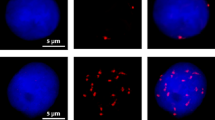Abstract
If individuals are exposed to ionising radiation, due to some radiation accident, for medical reasons, or during spaceflight, there is often a need to estimate the contracted radiation dose. The field of biodosimetry is concerned with estimating the dose retrospectively, using certain biomarkers, which are typically based on counts of some cytogenetic or biomolecular features of the cell arising after radiation-induced double-strand-breaks. Such techniques face particular challenges when the exposure is only partial rather than whole-body, which, when unaccounted for, may lead to grossly inaccurate dose estimates. For biomarkers which are overdispersed, there are currently no procedures available for the detection of partial-body exposures. We consider the question of estimating the exposure fraction as well as quantifying its uncertainty, using Bayesian and frequentist methods, by means of simulation scenarios which are motivated by overdispersed count data (nuclear foci) as arising for the γ −H2AX protein biomarker.
Access this chapter
Tax calculation will be finalised at checkout
Purchases are for personal use only
Similar content being viewed by others
References
IAEA: Cytogenetic Dosimetry: Applications in Preparedness for and Response to Radiation Emergencies. International Atomic Energy Agency, Vienna (2011)
Horn, S., Barnard, S., Rothkamm, K.: Gamma-H2AX-based dose estimation for whole and partial body radiation exposure. PLoS One 6, e25113 (2011)
Hilali, A., et al.: An appraisal of the value of the contaminated Poisson method to estimate the dose inhomogeneity in simulated partial-body exposure. Radiat. Res. 128, 108–111 (1991)
Szluinska, M., Edwards, A.A., Lloyd, D.C.: Statistical Methods for Biological Dosimetry. Health Protection Agency, Centre for Radiation, Chemical and Environmental Hazards. Radiation Protection Division (2005)
Rothkamm, K. et al.: Manual versus automated gamma–H2AX foci analysis across five European laboratories: can this assay be used for rapid biodosimetry in a large scale radiation accident? Mutat. Res 756, 170–173 (2013)
Lloyd, D.C. et al.: Chromosome aberration dosimetry using human lymphocytes in simulated partial body irradiation. Phys. Med. Biol. 18(3), 421–431 (1973)
Lloyd, D.C., Edwards, A.: Chromosome aberrations in human lymphocytes: effect of radiation quality, dose, and dose rate. Radiation Induced Chromosome Damage Man, 2349 (1983)
Oliveira, M., Einbeck, J., Higueras, M., Ainsbury, E., Puig, P., Rothkamm, K.: Zero-inflated regression models for radiation-induced chromosome aberration data: A comparative study. Biometrical J. 58, 259–279 (2016)
Einbeck, J., Ainsbury, E.A., Sales, R., Barnard, S., Kaestle, F., Higueras, M.: A statistical framework for radiation dose estimation with uncertainty quantification from the γ-H2AX assay. PLoS One 13(11), e0207464 (2018)
Ainsbury, E.A. et al.: Uncertainty on radiation doses estimated by biological and retrospective physical methods. Radiation Protection Dosimetry 178(4), 382–404 (2018)
Cucinotta, A., George, K., Wu, H.: Biodosimetry and Space Radiation Risks. In: 48th International Congress of Aviation and Space Medicine (2000)
Blakely, W.F., Miller, A.C., Grace, M.B., McLeland, C.B. et al.: Radiation biodosimetry: Applications for spaceflight. Adv. Space Res. 3(6), 1487–1493 (2003)
Yang, T.C., George, K., Johnson, A.S., Durante, M., Fedorenko, B.S.: Biodosimetry results from space flight Mir-18. Radiat. Res. 148, S17–S23 (1997)
Redon, C., Dickey, J.S., Bonner, W.M., Sedelnikova, O.: gamma-H2AX as a biomarker of DNA damage induced by ionizing radiation in human peripheral blood lymphocytes and artificial skin. Adv. Space Res. 43, 1171–1178 (2009)
Desai, N., Davis, E., O’Neill, P., Durante, M., Cucinotta, F.A., Wu, H.: Immunofluorescence detection of clustered gamma-H2AX foci induced by HZE-particle radiation. Radiat. Res. 164, 518–522 (2005)
George, K., Rhone, J., Chappell, L., Cucinotta, A.: Cytogenetic biodosimetry using the blood lymphocytes of astronauts. Acta Astronautica 92, 97–102 (2013)
Acknowledgements
We thank Dr David Endesfelder, BfS, Neuherberg, Germany, for providing some rjags code for zero-inflated models. We also thank the Cytogenetics Group at PHE, Didcot, UK, for providing the γ-H2AX data used in Sect. 4.
Author information
Authors and Affiliations
Corresponding author
Editor information
Editors and Affiliations
Appendix
Appendix
The following R code (used with package rjags) details the prior configurations used in Sect. 3. If the covariance matrix (betacov) is not available from the calibration curve (as in our case), it can be estimated from simulated data generated from that curve.
# Prior distribution for lambda f1 <- beta[1] + beta[2]∗D di[1] <- 1 di[2] <- D v <- inprod(di[1:2], betacov[1:2, 1:2] %∗% di[1:2]) lambda ~ dgamma(pow(f1, 2)/v,f1/v) # Prior distribution for alpha alpha ~ dgamma(0.005,0.01) # mean = 0.5, var = 50 # Prior distribution for dose D ~ dunif(0, 50) F ~ dbeta(1, 1) p <- (1-F) # F = 1-p assumption
Rights and permissions
Copyright information
© 2021 The Author(s), under exclusive license to Springer Nature Switzerland AG
About this paper
Cite this paper
Errington, A., Einbeck, J., Cumming, J. (2021). Estimating Exposure Fraction from Radiation Biomarkers: A Comparison of Frequentist and Bayesian Approaches. In: Vasile, M., Quagliarella, D. (eds) Advances in Uncertainty Quantification and Optimization Under Uncertainty with Aerospace Applications. UQOP 2020. Space Technology Proceedings, vol 8. Springer, Cham. https://doi.org/10.1007/978-3-030-80542-5_24
Download citation
DOI: https://doi.org/10.1007/978-3-030-80542-5_24
Published:
Publisher Name: Springer, Cham
Print ISBN: 978-3-030-80541-8
Online ISBN: 978-3-030-80542-5
eBook Packages: Physics and AstronomyPhysics and Astronomy (R0)



